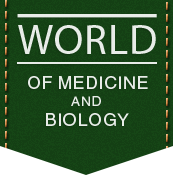| About the author: |
Ya. V. Rybalka, G. A. Yeroshenko, K. V. Shevchenko, O. B. Ryabushko, N. А. Ulanovska-Tsyba, A. S. Grygorenko, V. M. Sokolenko |
| Heading |
REVIEWS |
| Type of article |
Scentific article |
| Annotation |
In recent years, the structural organization and neurotransmitter nature of neurons in different parts of the rat cerebral cortex have provided the basis for further study and allowed the resulting experimental data to be extrapolated to humans in those aspects that are not related to the second signal system that is unique to humans. Advanced research methods have expanded the possibilities for research, so interest in studying the structural organization of the cerebral cortex has not abated to date. The cerebral cortex is the highest portion of the central nervous system. It is the youngest phylogenetically and the most complex part of the brain in terms of morphological and functional organization. It is the place of the highest analysis and synthesis of all the information entering the brain. It is the place where complex forms of behavior are integrated. The cerebral cortex is responsible for consciousness, thinking, memory, and “heuristic activity” (the ability to generalize and discover). A structural model based on systematic cortical variation captures the overall laminar structure of brain regions by dividing the cortical architectonic continuum into discrete categories (cortical types) that can be used to test hypotheses about cortical organization and function in different species, including humans. The architectonics data obtained from animal models provide an invaluable opportunity to reveal the complex interplay between structure and function in the mammalian brain. Extrapolation of these data from rodents to humans requires knowledge of the similarities and differences between species in anatomical features, and the factors that contribute to functional connectivity. Homologous functional networks are compared between species, and aspects such as global signal topography and the relationship between structural and functional connectivity are considered. |
| Tags |
cerebral cortex,rats,allocortex,olfactory sensory neurons,cortical amygdaloid nuclei,hippocampus,postrhinal cortex,isocortex |
| Bibliography |
- Bagalkot TR, Block ER, Bucchin K, Balcita-Pedicino JJ, Calderon M, Sesack SR, et al. Dopamine Transporter Localization in Medial Forebrain Bundle Axons Indicates Its Long-Range Transport Primarily by Membrane Diffusion with a Limited Contribution of Vesicular Traffic on Retromer-Positive Compartments. J Neurosci. 2021 Jan 13;41(2):234-250. doi: 10.1523/JNEUROSCI.0744-20.2020
- Fogwe LA, Reddy V, Mesfin FB. Neuroanatomy, Hippocampus. 2022 Jul 18. In: StatPearls [Internet]. Treasure Island (FL): StatPearls Publishing; 2022 Jan.
- Huang L, Chen Y, Jin S, Lin L, Duan S, Si K, et al. Organizational principles of amygdalar input-output neuronal circuits. Mol Psychiatry. 2021 Dec;26(12):7118-7129. doi: 10.1038/s41380-021-01262-3.
- Imamura F, Ito A, LaFever BJ. Subpopulations of Projection Neurons in the Olfactory Bulb. Front Neural Circuits. 2020 Aug 28;14:561822. doi: 10.3389/fncir.2020.561822
- Li DC, Dighe NM, Barbee BR, Pitts EG, Kochoian B, Blumenthal SA, et al. A molecularly integrated amygdalo-fronto-striatal network coordinates flexible learning and memory. Nat Neurosci. 2022 Sep;25(9):1213-1224. doi: 10.1038/s41593-022-01148-9.
- Manzini I, Schild D, Di Natale C. Principles of odor coding in vertebrates and artificial chemosensory systems. Physiol Rev. 2022 Jan 1;102(1):61-154. doi: 10.1152/physrev.00036.2020.
- Mathiasen ML, Nelson AJD, Amin E, O'Mara SM, Aggleton JP. A Direct Comparison of Afferents to the Rat Anterior Thalamic Nuclei and Nucleus Reuniens: Overlapping But Different. eNeuro. 2021 Sep 13;8(5):ENEURO.0103-20.2021. doi: 10.1523/ENEURO.0103-20.2021.
- Nagayama S, Homma R, Imamura F. Neuronal organization of olfactory bulb circuits. Front Neural Circuits. 2014 Sep 3;8:98. doi: 10.3389/fncir.2014.00098.
- Sánchez-Bellot C, AlSubaie R, Mishchanchuk K, Wee RWS, MacAskill AF. Two opposing hippocampus to prefrontal cortex pathways for the control of approach and avoidance behaviour. Nat Commun. 2022 Jan 17;13(1):339. doi: 10.1038/s41467-022-27977-7
- Sun X, Liu X, Starr ER, Liu S. CCKergic Tufted Cells Differentially Drive Two Anatomically Segregated Inhibitory Circuits in the Mouse Olfactory Bulb. J Neurosci. 2020 Aug 5;40(32):6189-6206. doi: 10.1523/JNEUROSCI.0769-20.2020.
- Swanson LW, Hahn JD, Jeub LGS, Fortunato S, Sporns O. Subsystem organization of axonal connections within and between the right and left cerebral cortex and cerebral nuclei (endbrain). Proc Natl Acad Sci USA. 2018 Jul 17;115(29):E6910-E6919. doi: 10.1073/pnas.1807255115.
- Vandrey B, Armstrong J, Brown CM, Garden DLF, Nolan MF. Fan cells in lateral entorhinal cortex directly influence medial entorhinal cortex through synaptic connections in layer 1. Elife. 2022 Dec 23;11:e83008. doi: 10.7554/eLife.83008
- Vertes RP, Hoover WB, Witter MP, Yanik MF, Rojas AKP, Linley SB. Projections from the five divisions of the orbital cortex to the thalamus in the rat. J Comp Neurol. 2023 Feb;531(2):217-237. doi: 10.1002/cne.25419.
- Xu N, LaGrow TJ, Anumba N, Lee A, Zhang X, Yousefi B, et al. Functional Connectivity of the Brain Across Rodents and Humans. Front Neurosci. 2022 Mar 8;16:816331. doi: 10.3389/fnins.2022.816331.
- Yao Z, van Velthoven CTJ, Nguyen TN, Goldy J, Sedeno-Cortes AE, Baftizadeh F, et al. A taxonomy of transcriptomic cell types across the isocortex and hippocampal formation. Cell. 2021 Jun 10;184(12):3222-3241.e26. doi: 10.1016/j.cell.2021.04.021.
- Yasushi M.. Operating principles of the cerebral cortex as a six-layered network in primates: beyond the classic canonical circuit model. Proc Jpn Acad Ser B Phys Biol Sci. 2022 Mar 11; 98(3): 93–111. doi: 10.2183/pjab.98.007
- Zhou K, Xu H, Lu S, Jiang S, Hou G, Deng X, et al. Reward and aversion processing by input-defined parallel nucleus accumbens circuits in mice. Nat Commun. 2022 Oct 21;13(1):6244. doi: 10.1038/s41467-022-33843-3.
|
| Publication of the article |
«World of Medicine and Biology» №2(88), 2024 year, 237-242 pages, index UDK 611.813.1-092.9 |
| DOI |
10.26724/2079-8334-2024-2-88-237-242 |
